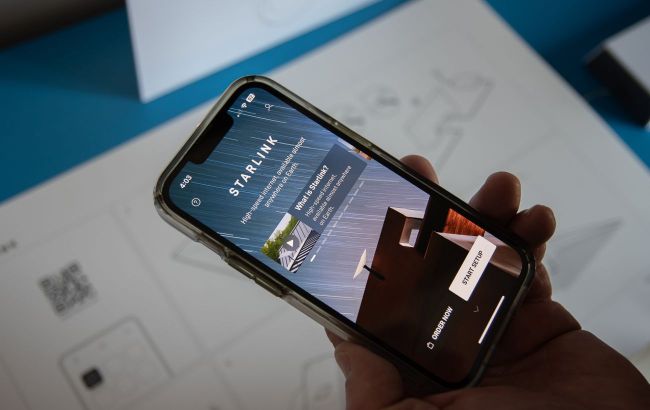SpaceX launches testing of Starlink direct internet connection to phones
 Testing of Starlink connection to mobile phones starts in three days (photo: Getty Images)
Testing of Starlink connection to mobile phones starts in three days (photo: Getty Images)
The vast Starlink network has already connected people around the world to the opportunities offered by the Internet. Now, SpaceX is preparing to expand Starlink's reach by beginning beta testing of Direct-to-Cell (DTC) satellites that will be able to connect mobile phones to cellular service from virtually anywhere on Earth, reports NASASpaceFlight.
Content
- The beginning of Starlink
- Expansion of Starlink capabilities
- How Direct-to-Cell works
- Global launch and future development
- The role of Starlink in the future of SpaceX
The beginning of Starlink
Starlink is SpaceX's low-Earth orbit (LEO) internet constellation of nearly 7,000 satellites. They provide high-speed internet to more than 4.6 million people in 118 countries on all continents. SpaceX launches batches of more than 20 Starlink satellites every week, some of which are equipped with the Direct-to-Cell feature.
The first operational Starlink satellites were launched on a Falcon 9 rocket on November 11, 2019. This mission put 60 satellites into a 550-kilometer orbit around the Earth. Launching into such an orbit allows achieving data transmission speeds more than 65 times higher than those of other Internet satellites in geostationary orbit.
Expansion of Starlink capabilities
In recent years, SpaceX has been working to expand the use of Starlink beyond regular households. It is now available in compact and mini formats for those who plan to use Starlink on the go. SpaceX also offers higher data rates for businesses on land, sea, and in the air.
Starlink is used not only on Earth, but also on the SpaceX Starship to improve communication with the spacecraft in space. This made it possible to receive impressive live broadcasts of Starship flights and its reentry into the Earth's atmosphere.
Previously, it was not possible to broadcast the re-entry of the vehicle due to the formation of plasma around the device at high temperatures. However, the constant transmission of data through Starlink satellites at an accelerated rate allows SpaceX to receive live images from cameras on spacecraft and broadcast them to websites.

Starship uses Starlink to collect images from cameras during re-entry during the spacecraft's sixth flight test (photo: SpaceX)
On August 25, 2022, SpaceX and several partner mobile operators around the world announced a plan to create satellites that will directly connect to the phones of these operators. This will make it possible to transmit messages, calls, and data anywhere where the sky is visible.
This technology will allow a person who is lost in the wilderness to call for help, no matter how far away from civilization or cell towers. Even before calling for help, the lost person will be able to use the data from the Direct-to-Cell (DTC) connection to find the route on any map and return to safety.
How Direct-to-Cell works
Starlink's DTC-enabled satellites will be equipped with an eNodeB modem, enabling them to act as cell towers in space. These tower satellites will instantly transmit data to Starlink's ground network and further to partner operators' networks, enabling the sending of messages and live phone calls.
The DTC-enabled satellites will continue to operate as standard Starlink satellites, expanding the communication capabilities for all Starlink users with each launch. The presence of a constellation of DTC-enabled Starlink satellites will almost completely eliminate dead spots around the world.
Moreover, this technology will work with existing phones and will not require new equipment to connect DTC.
SpaceX has officially requested a temporary permit to conduct experimental operations on DTC-enabled satellites, starting January 27, 2025. This will allow formal beta testing to begin for users of conventional mobile phones through SpaceX partner operators.

Starlink DTC diagram showing how data will be transferred between a mobile phone and Starlink (photo: SpaceX)
Global launch and future development
This beta launch will allow SpaceX and partner operators to understand what is required for the Starlink DTC constellation to function fully and without disruption. It is reported that the beta launch will be global, involving specific operators around the world.
This beta testing will be an important step in the development of DTC technology and will help create additional coverage from space for places where people may find themselves in emergency situations.
SpaceX will be testing DTC services for its Starlink satellites until July 26, 2025, at all stages of their missions: launch, early orbit, ascent, and operational phase.
If these tests prove to be successful and provide the expected data transfer speeds and reliability of coverage, SpaceX will be able to expand DTC services beyond the beta version to a full-fledged operating system.
The role of Starlink in the future of SpaceX
For SpaceX, a significant portion of Starlink's profits will be allocated to Starship development. This increase in profits will allow the company to accelerate the work without fear of financial losses in risky developments and programs.
Starlink has already shown that the creation of orbital cellular services around the world can change the way people communicate. Such services could save countless lives and become a standard for all operators, especially in emergency situations.

